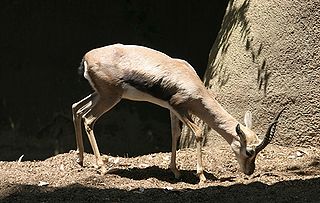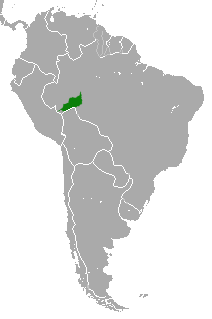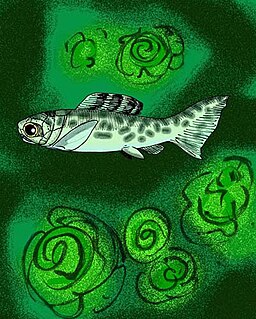
The little ringed plover is a small plover. The genus name Charadrius is a Late Latin word for a yellowish bird mentioned in the fourth-century Vulgate. It derives from Ancient Greek kharadrios a bird found in river valleys. The specific dubius is Latin for doubtful, since Sonnerat, writing in 1776, thought this bird might be just a variant of common ringed plover.

The bearded barbet is an African barbet. Barbets are near passerine birds with a worldwide tropical distribution, although New World and Old World barbets are placed in different families. The barbets get their name from the bristles which fringe their heavy bills.

Speke's gazelle is the smallest of the gazelle species. It is confined to the Horn of Africa, where it inhabits stony brush, grass steppes, and semi deserts. This species has been sometimes regarded as a subspecies of the Dorcas gazelle, though this is now widely disregarded. Severe habitat fragmentation means it is now impossible to assess the natural migratory or nomadic patterns of G. spekei. Its numbers are under threat, and despite an increase in population, the IUCN in 2007 announced its status had changed from vulnerable to endangered. A captive population is maintained, and the wild population exists in the lower tens of thousands. As of 2008, this gazelle is classified as endangered under the IUCN Red List.

Hershkovitz's titi is a species of titi, a type of New World monkey, from South America. It is found in Bolivia, Brazil, and Peru. The common name is in reference to American zoologist Philip Hershkovitz, who described the species as Callicebus dubius in 1988.

The greater adjutant is a member of the stork family, Ciconiidae. Its genus includes the lesser adjutant of Asia and the marabou stork of Africa. Once found widely across southern Asia, mainly in India but extending east to Borneo, the greater adjutant is now restricted to a much smaller range with only three breeding populations; two in India, with the largest colony in Assam, a smaller one around Bhagalpur; and another breeding population in Cambodia. They disperse widely after the breeding season. This large stork has a massive wedge-shaped bill, a bare head and a distinctive neck pouch. During the day, it soars in thermals along with vultures with whom it shares the habit of scavenging. They feed mainly on carrion and offal; however, they are opportunistic and will sometimes prey on vertebrates. The English name is derived from their stiff "military" gait when walking on the ground. Large numbers once lived in Asia, but they have declined to the point of endangerment. The total population in 2008 was estimated at around a thousand individuals. In the 19th century, they were especially common in the city of Calcutta, where they were referred to as the "Calcutta adjutant" and included in the coat of arms for the city. Known locally as hargila and considered to be unclean birds, they were largely left undisturbed but sometimes hunted for the use of their meat in folk medicine. Valued as scavengers, they were once depicted in the logo of the Calcutta Municipal Corporation.

Diaptomus is a genus of copepods with a single eye spot. It is superficially similar in size and appearance to Cyclops. However it has characteristically very long first antennae that exceed the body length. In addition, the females carry the eggs in a single sac rather than the twin sacs seen in Cyclops. It is a copepod of larger freshwater ponds, lakes and still waters.

A species that is extinct in the wild (EW) is one that has been categorized by the International Union for Conservation of Nature as known only by living members kept in captivity or as a naturalized population outside its historic range due to massive habitat loss.
Cycloramphus dubius is a species of frog in the family Cycloramphidae. It is endemic to the state of São Paulo, Brazil. Common name São Paulo button frog has been coined for it.
Callulops dubius is a species of frog in the family Microhylidae. It is endemic to Indonesia. Its natural habitat is subtropical or tropical moist lowland forests.

Philautus dubius is a species of frog in the family Rhacophoridae. It is endemic to India.

The rusty-capped fulvetta is a species of bird in the family Pellorneidae. It is found in Bhutan, China, India, Laos, Myanmar, and Vietnam. Its natural habitat is subtropical or tropical moist montane forest.
Notodiaptomus is a genus of copepods in the family Diaptomidae. It is the most widely distributed, most abundant and most species-rich genus of freshwater calanoid copepods in the Neotropics. The genus was erected in 1936 by Friedrich Kiefer for eleven species formerly placed in a wider Diaptomus. Notodiaptomus deitersi was chosen to be the type species by Raúl Adolfo Ringuelet in 1958.
Notodiaptomus maracaibensis is a species of calanoid copepod in the family Diaptomidae.

The San Cristóbal flycatcher, San Cristóbal vermilion flycatcher, or least vermilion flycatcher is an extinct species of flycatcher, closely related to the vermilion flycatcher. It was endemic to San Cristóbal Island in the Galápagos Islands. The taxon was discovered during Charles Darwin's Galapagos voyage in 1835 and described as full species Pyrocephalus dubius by John Gould in 1839.

Pristis is a genus of sawfish of the family Pristidae. These large fish are found worldwide in tropical and subtropical regions in coastal marine waters, estuaries, and freshwater lakes and rivers. Sawfish have declined drastically and all species are considered seriously threatened today.

The Nilgiris barb, also called the cock fish, is a tropical species of freshwater cyprinid fish. It is native to India. It is potamodromous, benthopelagic, and less than 25 cm long.
Geophis immaculatus is a small snake of the colubrid family. It is native to Mexico and Guatemala. There are no recognized subspecies. Although not much has been documented about it, the population distribution is in abundance and is of least concern in terms of conservation status.

Microsteus is a genus of small selenosteid arthrodire placoderms known from the Upper Frasnian Kellwasserkalk facies of Late Devonian Germany.

Pandanus dubius, commonly known as bakong or knob-fruited screwpine, is a species of Pandanus (screwpine) native to Island Southeast Asia, New Guinea, and the Western Pacific islands, and possibly also to the Andaman and Nicobar Islands.














